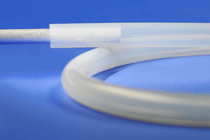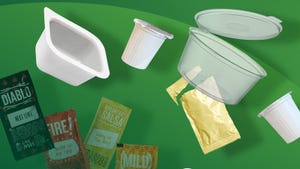Silicone developments help extruders succeed in medical, food industries
One of the world's leading suppliers of silicone rubber has spent considerable R&D time developing materials designed to help make life easier for extruders, including a grade for co-extrusion onto thermoplastics with no need for pretreatment. The new materials will be officially introduced during the K 2010 tradeshow, which begins Oct. 27 in Düsseldorf, Germany.
July 2, 2010
One of the world's leading suppliers of silicone rubber has spent considerable R&D time developing materials designed to help make life easier for extruders, including a grade for co-extrusion onto thermoplastics with no need for pretreatment. The new materials will be officially introduced during the K 2010 tradeshow, which begins Oct. 27 in Düsseldorf, Germany.
|
New grades from Wacker can help profile processors tackle new markets and applications. |
The supplier of the materials, Wacker Chemie, presented the developments during a pre-K press event in June. One of the new material ranges, Elastosil R plus 4366, allows for processing of materials with an intrinsically lubricious surface. Unlike with traditional oil-exuding silicones, no oily silicone film forms at the surface. Wacker says these elastomers offer high tear strength.
Parts made from these grades are simpler to install due to their low coefficient of sliding friction, so that use of release agents such as talcum may be unnecessary; often, reckons the supplier, assembly with tubes of profiles extruded from the material can be automated.
The reduced sliding friction also has a positive impact on the end application. For example, the lubricious surface of tubes used for metering products can make it easier to apportion solid food ingredients. In medical applications, the silicone products can facilitate the development of new types of catheters and drains that are easier to use and which patients find more comfortable.
All of the novel solid silicone rubber grades are transparent and can be dyed in any color. They cure by platinum-catalyzed addition. These elastomers comply with the food standards of the Federal German Institute for Risk Assessment (BfR), the French Arrêté du 25 novembre 1992 and the U.S. Food and Drug Administration (FDA).
Wacker also has developed a solid silicone rubber for extruded articles intended for the medical, pharmaceutical and biotech industries. Marketed under the name Silpuran 8630/60, it cures to a biocompatible elastomer. The product is certified to both ISO 10993-1 and USP (United States Pharmacopoeia) Class VI.
Still another new grade for profile extrusion, Elastosil R plus 4370/50, is a self-adhesive HTV silicone rubber which makes co-extrusion of multi-material parts possible. No pretreatment of the other extrudate is necessary; chemical adhesion and pressure-free bonding occurs within 2-3 minutes after the co-extruded part exits the die, says Wacker. The material can be co-extruded onto thermoplastic, elastomer and metal substrates. Direct chemical bonding of silicone to thermoplastics has long been available to injection molders, now profile extrusion processors have their chance too. —Matt Defosse
About the Author(s)
You May Also Like



